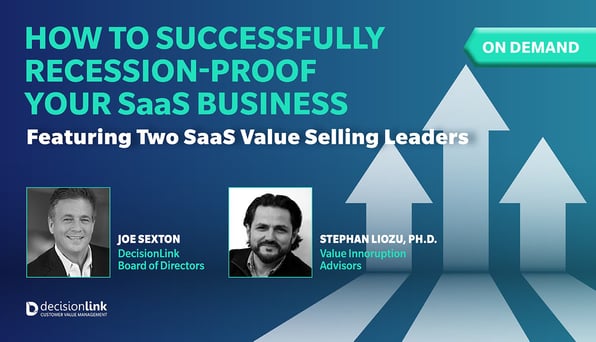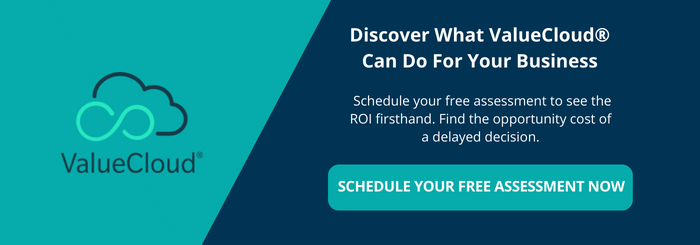How to Recession-Proof Your SaaS Business

5 tips to grow in an unfavorable market
Talks of an upcoming recession have prompted businesses to take a hard look at their revenue streams—and to find ways to boost their sales. Tackling the challenges ahead will require a new approach that emphasizes value to the customer. From initial conversations to renewals, customers need to understand the benefit they get from a product as they tighten their belts. To learn more about how businesses can beat the upcoming recession, we sat down with Joe Sexton, current Board of Advisors member at DecisionLink and former President of Worldwide Field Operations at AppDynamics, and Dr. Stephan Liozu, Founder of Value Innoruption Advisors. Sexton and Liozu offered five tips to recession-proof SaaS businesses.
Tip # 1: Revisit your core value proposition
As the economy changes, so do customers’ priorities. Your core value proposition must adapt to meet their needs. Liozu advised, “Reinforce, validate, and test your core value proposition to see if it's still valid in this context of recession.” It’s a sink-or-swim scenario: companies that don’t prove their worth will be the first that clients cut when they look to reduce their budgets.
The best way to do this is to engage in an ongoing conversation about value realization: Did your company deliver the value it promised? Establishing this practice before the recession is in full swing will enable you to build a track record of success. According to Sexton, the best companies regularly review clients’ ROI on a quarterly basis and use this information to course-correct immediately. Ultimately, it’s the customer who decides whether the value the software provides justifies its cost, so listening to the client is key.
Tip # 2: Monetize
Extract revenue and profit from all your offers. Whether it’s service, add-ons, or packages, don’t give away anything for free! One way to do this is to charge for professional consulting services. “A lot of times clients will have a budget set aside for services, separate from the software spend,” Sexton explained, because they know that successful adoption takes additional resources.
SaaS companies don’t always take advantage of this line item. In the process, they miss out on the opportunity not only to improve their cash flow during an economic crunch but also to help the client extract more value from their product—which boosts retention in the long run. Liozu concludes, “If you can make a dollar today or $10,000 in consulting or whatever the customer needs and you can charge for it, just take it.”
Tip # 3: Restructure marketing programs
For companies to consistently deliver on their promises, marketing and sales must be aligned. Before customers are even approached for a sale, they must have a good understanding of what the product can do for them and how it differs from other options. Too many companies say the same things, and those that don’t differentiate will lose out during a recession.
“There are so many SaaS companies out there that SaaS marketing has become boring, same webinars, same white papers, same blogs, you know, everybody's doing the same,” Liozu said. “And right now, how do you cut through the noise? How do you bring value through marketing to your customers and prospects today?” One way is for marketing to shift its mindset towards a more outcome-oriented approach. Hiring a consulting firm to do market research to help customers in the discovery phase can be a worthwhile investment.
Tip # 4: Invest in customer value management
In a recession, your business is competing not only against others in the industry but also against other uses of the customer’s resources. To ensure that you prove your value to key decision-makers, create internal champions of your product. That means sitting down with the client and going over the value equation to show them specifically what your software can do for their business.
Customer value management makes the key connection between potential prospects and committed customers. Too often, this part of the sales funnel is neglected. “What I see with sales organizations is that they spend a lot of money at the top of the funnel with prospecting, but if you look at their funnel, it’s very top heavy and it looks like a spinning top with a very small pipeline at the end,” Sexton said. Prospective clients don’t have enough support to move to the next stages of the sales funnel.
Proving the value of your product is key to unlocking those critical next steps. Quantify the benefit customers can expect by using your product and they’ll feel a sense of security, moving them from indecision to commitment—and creating more wins.
Tip # 5: Refresh your pricing approach
Consider your offerings and how you might re-package them to better appeal to the consumer. The beauty of flexible payment terms, according to Sexton, is that the more value the client sees from the solution, the more they want to buy. Because service is ongoing, they can always buy add-ons when they see fit.
“We want to get the camel’s nose under the tent,” Sexton said. “Because once that happens, and our software does what we say it does, eventually the whole camel is in the tent.” If you’re confident in your product, letting the customer take baby steps toward full service is a great way to bet on yourself.
Get to know our panelists:

Dr. Stephan Liozu is the Founder of Value Innoruption Advisors.

Joe Sexton is currently a member of the DecisionLink Board of Advisors and former President of Worldwide Field Operations at AppDynamics.
Be sure to listen to the full conversation from "How to Recession-Proof Your SaaS Business."

 ValueCloud
ValueCloud
.png?width=118&height=76&name=Rectangle%20(3).png) ValueCloud Ignite
ValueCloud Ignite
.png?width=92&height=92&name=Rectangle%20(4).png) Free Assessment
Free Assessment
.png?width=100&height=100&name=Rectangle%20(5).png) Watch a Demo
Watch a Demo
.png?width=82&height=96&name=Rectangle%20(6).png) Value Calculator
Value Calculator

.png?width=62&height=51&name=Group%2010%20(1).png) Marketing
Marketing
 Sales
Sales
 Customer Success
Customer Success
 Engage Prospects
Engage Prospects
 Win Deals Faster
Win Deals Faster
 Retain Customers
Retain Customers
.png?width=62&height=62&name=Rectangle%20(8).png) Adopt and Scale
Adopt and Scale
.png?width=54&height=54&name=Rectangle%20(9).png) Cybersecurity
Cybersecurity
 Healthcare
Healthcare
.png?width=54&height=54&name=Rectangle%20(10).png) IT & Software
IT & Software




